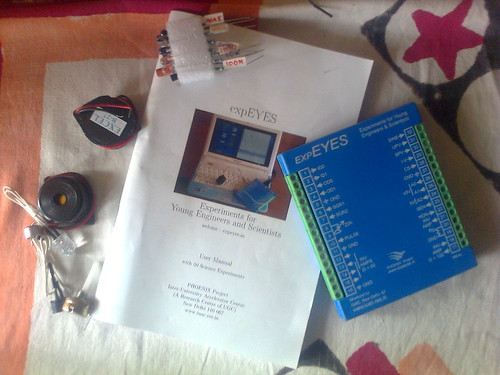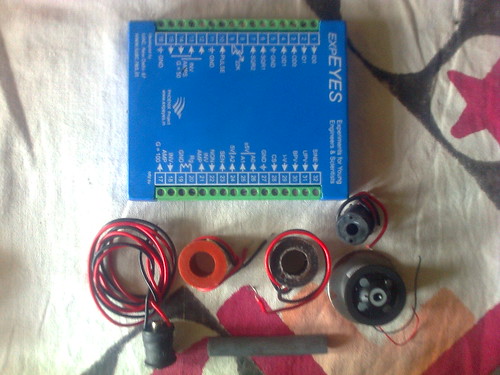Introducing Phoenix expEYES, a low cost open hardware/free software tool for hardware hackers
Phoenix expEYES - an exciting tool for the hardware hacker!
April 25, 2011
ExpEYES is from the PHOENIX project of Inter-University Accelerator Center, New Delhi. It is a hardware & software framework for developing science experiments, demonstrations and projects and learning science and engineering by exploration. Capable of doing real time measurements and analysing the data in different ways. Analog voltages, in +/- 5 volts range, are measured with 12 bit resolution (around 1.25 millivolts) and time intervals with one microsecond. The project is based on Free and Open Source software, mostly written in the Python programming language. The hardware design is also open.
The expEYES hardware is interfaced and powered by USB, having a size of 11 x 9 x 1.5 cm and weighs 150 gm. There are 32 terminals arranged in two rows where you can connect external signals, within +/-5 volts range, for control and measurement. It can function as a signal generator, frequency counter and low frequency oscilloscope . The user manual documents about 50 experiments that can be done using expEYES.
Visit the expEYES home page to learn more about the project and its capabilities; you can also check out the User Manual.
The Phoenix project has come a long way, thanks to the dedicated effort of Ajith Kumar and friends at the Inter-University Accelerator Center. The device which I documented in a Linux Gazette article six years back was a bulky unit interfaced to the PC using the parallel port. This was later changed to a more compact design using an Atmel AVR processor. The software too evolved to include a lot of functionality. The most recent version (called expEYES) interfaces with the PC using the USB port, does not need any extra power source and is very compact. Plug in the device, boot an Ubuntu live CD, and you are ready to go!
expEYES is open hardware - you can go ahead and use the schematics and PCB files to roll your own device. Or, you can get it from a vendor like zyxware. If you are purchasing from a vendor, you have an option to get the device as well as a complete set of accessories (magnets, motors, coils ... ) - you can immediately dive into the user manual and start doing cool experiments like study of sound interference patterns!
You will find Phoenix expEYES to be a wonderful tool if you are:
- A free software enthusiast, with a taste for science and electronics. The Phoenix user-level framework is written completely in Python. Reading and understanding the code is a good learning experience - you can think of creating fun experiments of your own! You might also think of developing more software (like say an oscilloscope with a superb graphical interface).
- A BSc/MSc level science student with an interest in pursuing a career in experimental Physics.
- A hardware hacker / electronics/embedded systems student/hobbyist . You gain access to a complete "programmable electronics lab" for conducting lots of interesting experiments. The core Phoenix code is written in C and runs on an AVR microcontroller. Reading the code and improving it will be a great learning experience.
- A physics/engineering teacher. Take an expEYES box, a laptop and an LCD projector to the classroom and convert a dry "theory" lecture into an exciting demo! (Check out the amazing series of lectures by Prof.Anant Agrawal if you wish to see how an electronics lab can be brought into the classroom).
- A bright and enthusiastic school student interested in science. You will realize that you can use your PC for doing much more than watching movies, playing games and idling away on "social networking" sites! expEYES brings together programming, electronics and physics in a way that will get students hooked to science and technology!

